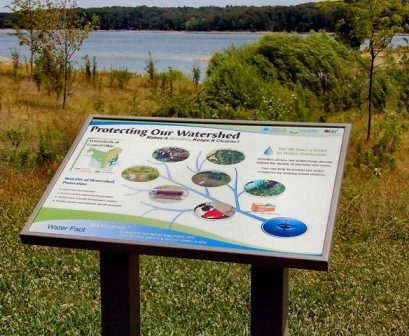Native Vegetation Protects Our Waterways
Our Watershed Management Section implements proven best management practices around Columbus' reservoirs for the purposes of increased water quality and as an educational example for our neighboring communities.
Every time it rains, pesticides, fertilizers, loose dirt and other pollutants are washed from impermeable (hard, non-penetrating) surfaces like roads and parking lots into our waterways. When we landscape with plants native to our area, we can protect the quality of water from such runoff in our reservoirs, rivers and streams. The plants’ long roots slow the flow of stormwater, soak up and filter contaminants and hold the soil in place. That results in less flooding, fewer pollutants and decreased erosion.
Providing a deep-rooted vegetative buffer around a body of water (photo below) provides many environmental benefits including better water quality. Such buffers around a reservoir are especially important when there is substantial development nearby.

Native landscaping also reduces time and money invested in gardening. Plants native to Ohio thrive in the weather and soil conditions found here, so there is no need for watering or fertilizing. This means a savings on water, chemicals and energy. The plants also provide food and shelter for birds, butterflies and beneficial insects, such as dragonflies that eat mosquitoes.
Resources and related links to help you get started include:
Native Plants with long roots slow the flow of stormwater, soak up and filter contaminants and hold the soil in place contributing to better water quality. Find a list of plants native to Hoover or to Griggs and O'Shaughnessy Reservoirs.
Other links:
US EPA – GreenScaping
Central Ohio Rain Garden Initiative
Franklin Soil and Water Conservation District
Friends of the Lower Olentangy Watershed
 GREEN INFRASTRUCTURE PROTECTS WATER
GREEN INFRASTRUCTURE PROTECTS WATER
Green infrastructure can improve the quality of storm water entering the reservoirs that supply our drinking water. Follow signage installed at Griggs, O'Shaughnessy & Hoover Reservoirs which invites park visitors to learn about the green infrastructure installed there. Take a Tour to learn more.